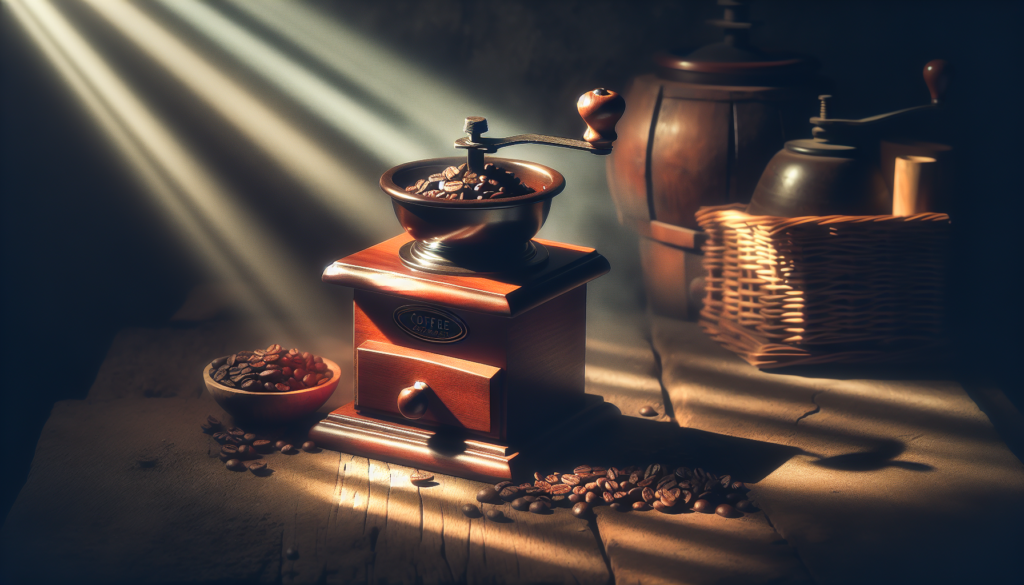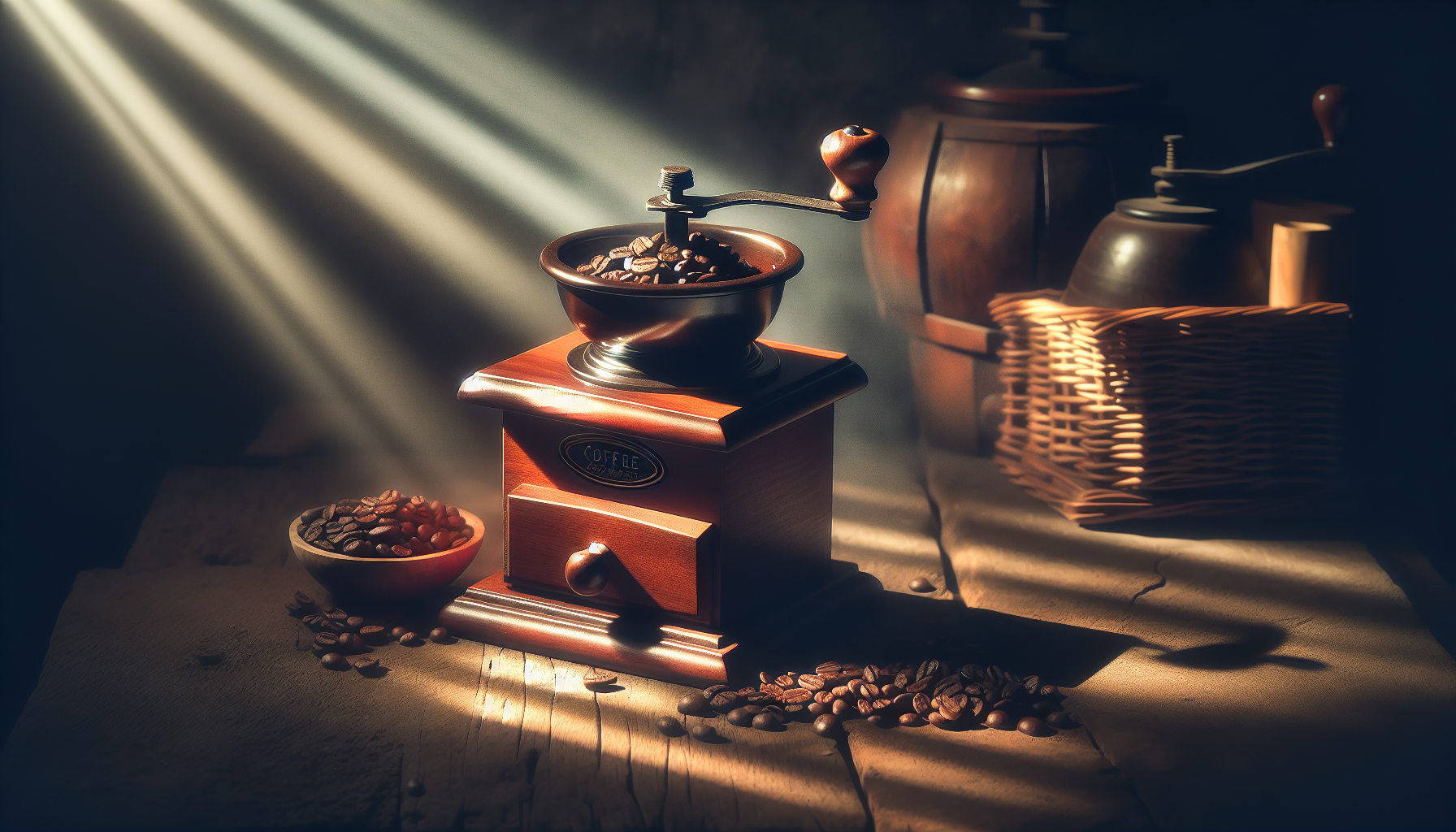You love the aroma and flavor of freshly ground coffee, but you’re not quite sure how to achieve that perfect grind by hand. In this article, we will explore the art of manually grinding coffee beans and provide you with simple steps to harness the full potential of your beans. Whether you’re a coffee connoisseur looking to enhance your brewing experience or a novice seeking to elevate your morning cup, we’ve got you covered. So grab your coffee grinder and let’s embark on a delightful journey to discover the wonders of hand-ground coffee.

CHECK OUT COFFEE GRINDERS ON AMAZON
Choosing the Right Beans
When it comes to selecting high-quality coffee beans, there are a few factors to consider. First, determine whether you prefer Arabica or Robusta beans. Arabica beans are known for their smooth and nuanced flavors, while Robusta beans have a stronger, more bitter taste. Next, consider the roast level that suits your palate. Light roasts retain the beans’ natural flavors, while dark roasts create a bolder and more pronounced taste. Lastly, think about the origin of the beans. Coffee beans from different regions have distinct flavor profiles, so choose based on your preferences.
Grinding Equipment Options
Grinding your coffee beans by hand requires the right equipment. There are several options to choose from, depending on your preference and budget. A manual coffee grinder, also known as a hand grinder, offers precision and control over the grind size. It allows you to adjust the grind according to your brewing method. If you don’t have a hand grinder, you can also use a mortar and pestle, a rolling pin and plastic bag, or even a blender or food processor.
Preparing the Beans
Before grinding your coffee beans, it is essential to prepare them properly. If you have green coffee beans, you will need to roast them first. Roasting can be done in a variety of ways, such as using an oven, stovetop, or dedicated coffee roaster. Once roasted, let the beans cool down to room temperature to avoid condensation. Then, weigh the desired amount of beans for your brew. It is best to grind only the amount you need for immediate use to maintain freshness. Store any unused beans in an airtight container to preserve their flavor.
Using a Manual Coffee Grinder
To grind your coffee beans using a manual coffee grinder, start by adjusting the grind size according to your brewing method. For a coarse grind, suitable for French press or cold brew, choose a larger setting. For fine or espresso grind, opt for a smaller setting. Next, place the desired amount of beans in the grinder. Make sure to hold the grinder securely to prevent any accidents. Then, rotate the handle in a steady and consistent motion, feeling the beans being ground. Once grinding is complete, check the consistency of the ground coffee, adjusting the grind size if necessary.
Grinding with a Mortar and Pestle
Using a mortar and pestle is another option for grinding coffee beans by hand. Choose a suitable mortar and pestle for this task, ensuring they are clean and dry. Start by adding a small amount of beans to the mortar, as grinding too many at once can be challenging. Apply pressure to the beans using the pestle while grinding in a circular motion. Continue this process until the desired consistency is achieved. Remember to take breaks to prevent overheating the beans and maintain control over the grind size.
Crushing with a Rolling Pin and Plastic Bag
If you don’t have a dedicated coffee grinder or mortar and pestle, you can use a rolling pin and plastic bag to crush the beans manually. Place the coffee beans inside a sturdy plastic bag, ensuring it is sealed and removing any excess air. This method helps contain any mess while preserving the beans’ aroma. Use the rolling pin to crush the beans by rolling it back and forth over the bag. Repeat this process until you achieve the desired grind size. The advantage of this method is its simplicity and accessibility.
Utilizing a Blender or Food Processor
While not as traditional as other methods, using a blender or food processor can be a convenient way to grind coffee beans by hand. Start by pouring the beans into the blending container, ensuring it is clean and dry. It is essential to pulse the blender instead of running it continuously to avoid overheating the beans. After each pulse, pause and check the grind consistency. If needed, re-blend the beans for a few more pulses until you reach the desired grind size. Keep in mind that this method may produce a less uniform grind compared to the others.
Factors Affecting Grind Size
The grind size of your coffee beans plays a crucial role in the taste and quality of your brew. Several factors can influence the ideal grind size for your brewing method. The first consideration is the brewing method itself. For example, French press and cold brew require a coarse grind, while espresso demands a fine grind. Additionally, the size and density of the beans can impact the grind. Smaller beans tend to require a finer grind, while larger beans may need a coarser grind. Furthermore, factors like temperature and humidity can affect how the beans grind, so adjust accordingly. Lastly, personal preference is essential, as you can experiment with different grind sizes to find your perfect cup of coffee.
CHECK OUT COFFEE GRINDERS ON AMAZON
Storing Ground Coffee
Proper storage of ground coffee is crucial to maintain its freshness and flavor. After grinding your beans, it is best to transfer the coffee into an airtight container. This will help prevent exposure to air and moisture, which can quickly degrade the quality of the coffee. Additionally, keep the ground coffee container away from direct light and heat sources, as they can cause the coffee to lose flavor and freshness. Avoid storing excessive amounts of ground coffee, as it is best to grind the beans just before brewing to ensure the most flavorful cup.
Cleaning and Maintenance
To ensure the longevity and optimal performance of your grinding equipment, regular cleaning and maintenance are necessary. After each use, take the time to clean the grinder, mortar and pestle, rolling pin, plastic bag, blender, or food processor. Remove any leftover coffee grounds or debris to prevent them from impacting the flavor of future brews. Check for any signs of wear or damage, such as dull blades or cracked parts, and address them accordingly. Lastly, always follow the manufacturer’s instructions for cleaning and maintenance to ensure the best results.
In conclusion, grinding your coffee beans by hand can be a rewarding and enjoyable process. Consider the type of beans, the roast level, and the origin to choose the right beans for your taste. Explore different grinding equipment options, such as a manual coffee grinder, mortar and pestle, rolling pin and plastic bag, or blender and food processor. Follow proper preparation techniques, adjust grind sizes accordingly, and take into account factors that affect the grind size. Lastly, store ground coffee properly, clean and maintain your equipment regularly, and enjoy the process of crafting your perfect cup of coffee. Happy grinding!

